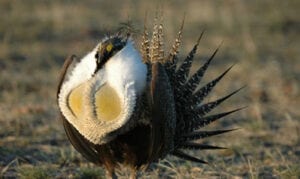Audubon Warns Interior’s Industry-Friendly Plans Put Sage-Grouse at Risk

On December 6, 2018, the Department of the Interior announced its decision to replace the landmark 2015 Greater Sage-Grouse conservation agreement with a new set of Bureau of Land Management (BLM) plans that more heavily favor oil and gas development.
“A fractured approach to sagebrush conservation will not work. The best chance to protect sage-grouse and more than 350 other species is through a landscape-wide conservation strategy, which is what we achieved in 2015,” said Brian Rutledge, director of Audubon’s Sagebrush Ecosystem Initiative.
“Out West we know a deal is a deal. To have plans that took years of work, backed by good science and strong public support, brought into question is disheartening, a waste of tax-payers money and will threaten our public lands.
“Regardless of today’s decision, Audubon and our partners remain committed to protecting this irreplaceable landscape and will remain at the table to ensure future generations can appreciate this truly special and underappreciated place.”
Strong Support from Westerners for Sage-Grouse Protections
Overwhelming majorities of Westerners have asked the Secretary of the Interior to honor the 2015 agreement, which is the greatest example of landscape conservation in American history. Since Secretary Ryan Zinke first decided to revisit the BLM plans, more than 40 thousand Americans, including approximately 15 thousand Audubon members and supporters, submitted comments to Interior opposing modifications of the agreement.
In a poll conducted earlier this year by Colorado College, nearly two-thirds of voters from Western states expressed opposition to changing the sage-grouse conservation plans.
Scientific Concerns with Zinke’s Approach to Sage-Grouse
In June 2018, more than twenty scientists sent a letter to Secretary Zinkeoutlining concerns with the proposed changes made final today. The scientists concluded, “failure to take into account large-scale dynamics when managing sage-grouse will likely lead to an overall loss of habitat quantity and quality resulting in population declines.”
Background on Landmark 2015 Sage-Grouse Agreement
In 2015, Western states, federal agencies, energy executives, ranchers, sportsmen, scientists and other stakeholders came together to celebrate collective commitments to sage-grouse conservation, securing a “not warranted” finding with regard to Endangered Species Act (ESA) protections. A finding now more uncertain after today’s decision.
More than 350 other species of wildlife, including many other species of birds, depend on a healthy sagebrush ecosystem. For example, Burrowing Owls often make their homes underground in abandoned prairie dog dens. Sage Thrashers can be heard singing atop sagebrush plants during breeding season as can the brightly-colored Western Meadowlark, the state bird of many Western states including Montana, Oregon, North Dakota and Wyoming.
Read the full press release from Audubon here.
